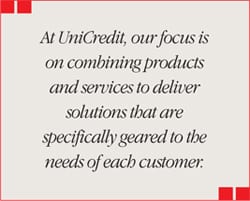After the Ballots
How the ‘year of elections’ reshaped treasury priorities
Published: October 10, 2014

Working capital optimisation is a priority for corporations globally, a trend that we expect to grow as banks adopt Basel III leading to ongoing constraints in the cost and availability of capital. A major component of our Global Transaction Banking (GTB) strategy at UniCredit is to support customers in managing their working capital needs globally through innovative financing solutions and advisory services. By taking a global approach and leveraging our skills, experience and technology across the bank, we are able to offer customers a cohesive value proposition in our core markets. This approach allows us to deliver innovative solutions that meet the specific needs of our customers, not only in our home markets but across our footprint. This article outlines the experiences of a major customer with whom we recently completed a supply chain finance project, which was spearheaded by UniCredit New York but relied on considerable collaboration across the bank.

There is a tendency to think of many GTB solutions, such as payments, collections and cash management, as commoditised products. However, at UniCredit, our focus is on combining products and services to deliver solutions that are specifically geared to the needs of each customer. While every organisation has a different business strategy, organisational structure and risk appetite, ultimately the aim of every business is to maximise shareholder value; however, this is achieved through a wide variety of means. For large multinationals operating in low margin industries, there is no room for inefficiency in financing, business processes or supply chain management. These companies therefore rely on their banking partners to provide scalable solutions that reduce the margin for error and inefficiency, and deliver demonstrable value.
This was the expectation of one of the largest global technology companies, which has substantial business activities across both Europe and North America. The Treasury Department is highly centralised, in order to achieve operational and financial efficiency, build economies of scale and observe risk and compliance requirements. The company had already enjoyed a decade-long relationship with UniCredit in US, Germany and Central & Eastern Europe, and therefore sought our support in achieving these objectives.
With a customer base extending into the hundreds of thousands, from the world’s largest multinationals to small & medium enterprises (SME) in multiple countries and with diverse collection methods, the company was experiencing considerable challenges in optimising working capital and managing credit risk.

The company approached UniCredit to optimise working capital by minimising days sales outstanding (DSO). This resulted in the development of a new receivables purchase programme, outlined in figure 1.
This involved consolidating and financing receivables from thousands of SME customers, supported by a $100m credit facility. Also involved was a vendor financing partner that is specialised in financing a large number of customers. Consequently, UniCredit purchases the receivables that our customer holds against the vendor partners.[[[PAGE]]]
Bearing in mind the scale of the programme, it was essential that processes could be automated as far as possible, supported with sophisticated reporting and analysis. To achieve this, we provided the customer with our industry-leading supply chain finance platform (UCSF). While this platform is well-established in Europe, this was the first implementation in the US. We worked closely with our product development team to meet the customer’s specific requirements, including adaptations for the US market.
The receivables programme went live during the second quarter of 2014 after a 12 month period of development. The benefits to the customer (Company A in figure 1) have been substantial and meet its operational, credit risk, working capital objectives very specifically, without compromising customer relationships. For example:
Automation – invoices are uploaded directly to UCSF without the need for manual processing. UCSF provides sophisticated reporting and analysis to support the programme and enable the company to quantify the benefits.
Credit risk – the company is no longer subject to credit risk to customers included in the programme. Similarly, UniCredit’s sole credit risk is to the vendor finance partner, a highly reputable company, leading to a ‘win win’ on all sides. This has been achieved without any inconvenience to customers, therefore enhancing the company’s ability to do business.
Working capital – the company receives a predictable, single payment from UniCredit, therefore enabling it to forecast cash flow more accurately and plan liquidity.
This was the first joint supply chain financing solution set up by UniCredit in New York, and the first that involved implementing UniCredit’s innovative supply chain finance platform directly on a customer’s site. The project involved global collaboration both within UniCredit and the customer’s organisation, including legal, IT and finance to ensure a common vision and clear expectations of project deliverables.
More generally, the project illustrates UniCredit’s position as an important player in the United States, supporting customers from our home markets in their global cash, treasury and working capital requirements. This receivables purchase programme is an important example of the way in which we design and deliver solutions to our customers. Specifically, it is straightforward and transparent, with a clear value proposition, but supported with a robust platform that offers a high level of automation and sophistication. Our solutions are tailored to the requirements of each customer, which are scalable in order to meet their changing needs.
Looking ahead, we are seeing considerable interest from our customers – to leverage our expertise, proven track record and innovative eCommerce platform in order to achieve similar benefits.

